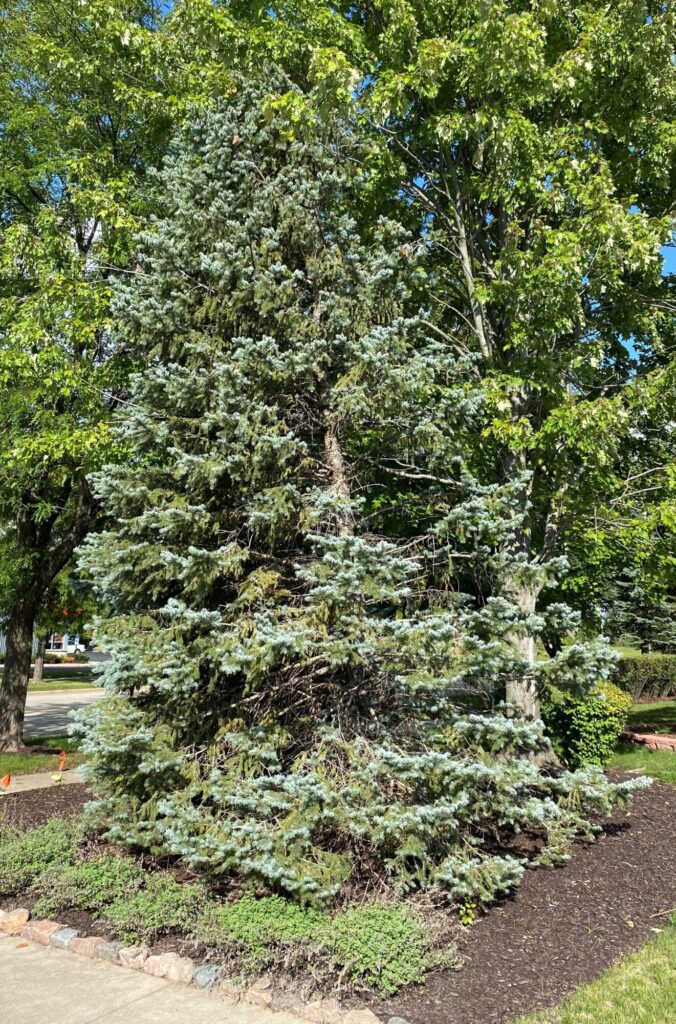If you have blue spruce trees in your Illinois landscape, you’ve likely noticed their striking beauty and unique character. However, maintaining these trees can be challenging, especially in a climate that’s far from their native range. Blue spruce trees are beloved for their striking blue-green needles and pyramid-like shape. These elegant evergreens can add beauty and value to any landscape. However, they are not immune to diseases that can threaten their health and aesthetics.
Blue spruce trees are not native to Illinois, and this difference in climate and soil conditions can make them more susceptible to various problems, particularly fungal infections. These issues can lead to defoliation, canopy thinning, and damage to the tree’s trunk and stem tissues. While the list of potential problems is extensive, we’ll focus on two of the most common issues encountered in Illinois.
Needle Cast
One of the most prevalent challenges for blue spruce trees in Illinois is needle cast diseases. These diseases are caused by fungal pathogens that infect the needles, resulting in browning and eventual needle drop.
- Needle cast diseases typically start from the lower branches and work their way upward
- As the infection progresses, it moves from the inner canopy towards the branch tips, causing a phenomenon known as “lion’s tailing,” where branches may be bare of needles except for a tuft at the ends
- If left untreated, multiple-year infections can kill branches and significantly thin the canopy, affecting the overall health and appearance of the tree

Our plant health care team can greatly reduce or prevent needle cast diseases with a series of annual fungicide sprays applied after new needles emerge in the spring.
- Successive spring applications of fungicides can significantly improve the appearance and health of infected trees
- Additionally, our team recommends the application of Cambistat growth regulator to enhance plant vigor and resilience against the disease
Canker Disease
Canker diseases are another common issue affecting blue spruce trees in Illinois. These infections target branches and trunks, creating blisters under the bark that cause sap to flow down the trunk.
- Canker infections often lead to dead or dying branches starting from the bottom of the tree and progressing upwards
- The trunk may also exhibit discoloration due to sap flow, usually appearing white or tan
- Canker diseases are very serious and can prove fatal if left untreated, making prompt action essential

Our plant health care team can reduce the spread of canker disease and manage the infection, ultimately increasing the longevity of valuable mature trees.
- Annual applications of phosphoric acid can help elicit an immune response, enhancing the tree’s production of proteins and cell walls to combat the infection using its natural defenses
- In severe cases, our team may recommend applications in both spring and fall for optimal results
- Like with needle casts, the application of Cambistat growth regulator is also suggested to bolster plant vigor and resilience against the disease
While blue spruce trees in Illinois face unique challenges due to their non-native status, they can thrive with proper care and attention. By recognizing the symptoms and understanding the solutions presented above, you can take proactive steps to maintain the health and beauty of your blue spruce trees, ensuring they continue to enhance your landscape for years to come. Our dedicated plant health care team is here to assist you in preserving these majestic trees and addressing the specific issues they may encounter in the Illinois climate. Give Homer Tree Care a call today!

